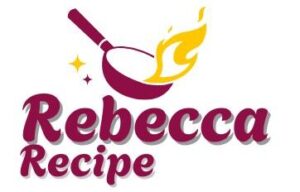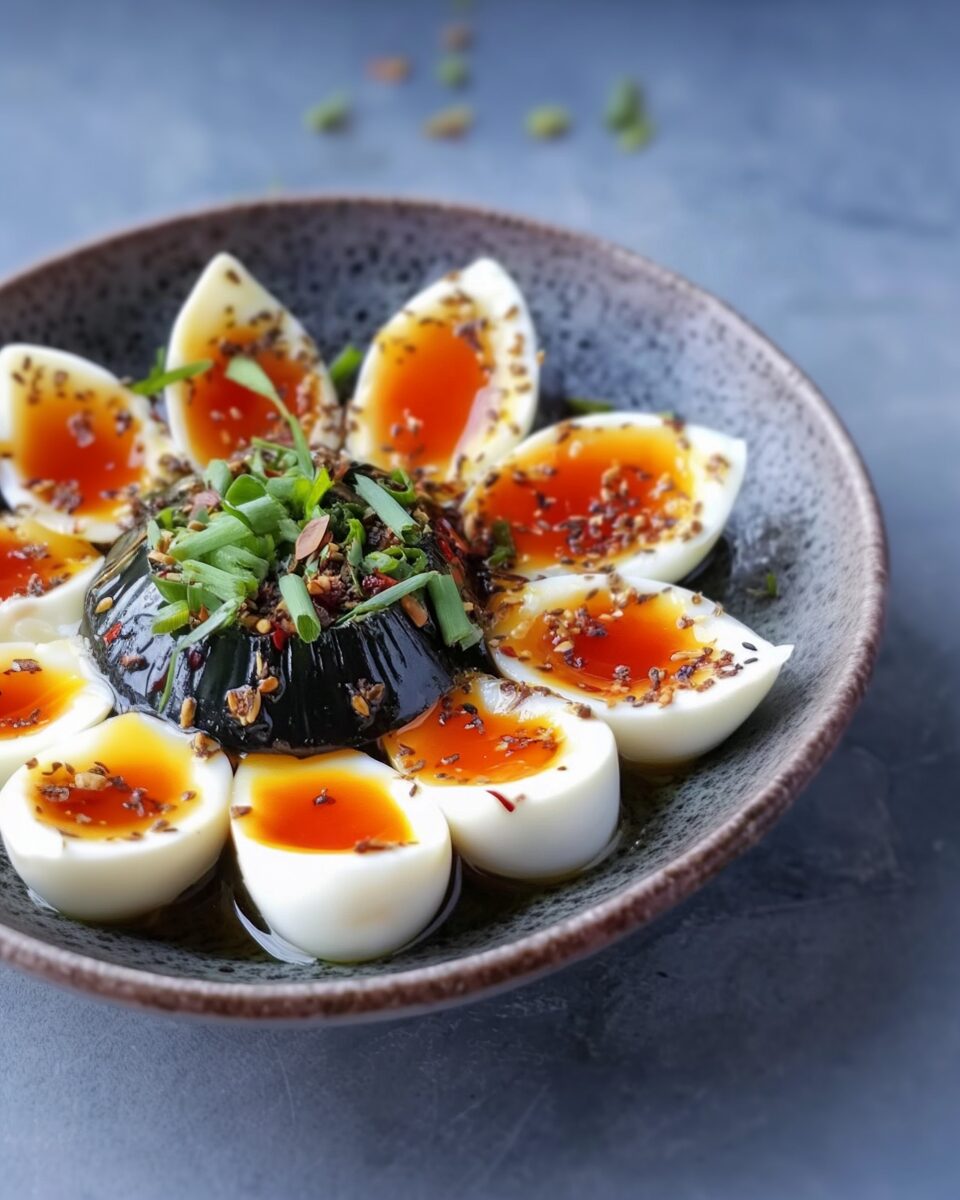Century eggs, also known as preserved eggs or hundred-year eggs, are a traditional Chinese delicacy that has been enjoyed for centuries. Despite their name, century eggs are not actually a hundred years old; rather, they are eggs—typically duck, chicken, or quail eggs—that have been preserved through a curing process involving clay, ash, salt, quicklime, and rice husks. This process transforms the egg white into a dark amber, translucent jelly, while the yolk becomes a greyish-green with a creamy texture. The resulting flavor is rich and savory, often likened to mature cheese with a hint of ammonia. Century eggs are commonly used in various Chinese dishes, including salads, congee, and stir-fries.
Full Recipe:
Ingredients
- 4 century eggs
- 1 block of silken tofu
- 2 tablespoons soy sauce
- 1 tablespoon rice vinegar
- 1 teaspoon sesame oil
- 1 teaspoon sugar
- 1 small garlic clove, minced
- 1 tablespoon chopped cilantro
- 1 tablespoon chopped scallions
- 1 small red chili, thinly sliced (optional)
Directions
- Peel the century eggs and cut them into wedges.
- Slice the silken tofu into bite-sized cubes and arrange them on a serving plate.
- Place the century egg wedges on top of the tofu.
- In a small bowl, whisk together the soy sauce, rice vinegar, sesame oil, sugar, and minced garlic until the sugar dissolves.
- Pour the dressing evenly over the tofu and century eggs.
- Garnish with chopped cilantro, scallions, and sliced red chili, if using.
- Serve immediately as a refreshing appetizer or side dish.
Nutritional Facts (per serving)
- Calories: Approximately 120 kcal
- Protein: 8 g
- Fat: 8 g
- Carbohydrates: 4 g
- Fiber: 1 g
- Sodium: 300 mg
- Cholesterol: 150 mg
A Cultural Icon in Chinese Cuisine
Century eggs have been a staple in Chinese culinary traditions for centuries, and their history dates back to the Song Dynasty (960-1279 AD). Over the years, century eggs have become an iconic ingredient, used in a wide variety of dishes across China and other parts of East Asia. In addition to their cultural significance, century eggs also serve as a symbol of preservation, showcasing how ancient techniques have stood the test of time.
In Chinese culture, century eggs are often enjoyed as an appetizer or side dish and are commonly paired with tofu, porridge (congee), or even served as part of a larger meal. The eggs are highly prized for their ability to add complexity and richness to dishes, thanks to their unique texture and strong flavor.
The Nutritional Value of Century Eggs
While century eggs are often considered an acquired taste due to their strong flavor and smell, they also pack a significant nutritional punch. These eggs are rich in protein, essential amino acids, and healthy fats, making them a valuable source of nutrition. Additionally, they are a good source of iron, calcium, and other vital minerals that support overall health.
The process of preserving century eggs enhances their nutritional profile by breaking down the proteins and making them more digestible. This makes them an excellent choice for individuals with sensitive stomachs or those who need a nutrient-dense food that is easy to consume.
Century Eggs in Traditional Dishes
Century eggs are commonly used in a variety of traditional Chinese dishes, adding an exciting depth of flavor to the cuisine. Some of the most popular dishes that feature century eggs include century egg salad, century egg congee, and century egg stir-fries. These dishes often pair the eggs with complementary ingredients such as silken tofu, rice, and aromatic herbs like cilantro and scallions.
One of the most popular ways to enjoy century eggs is in a simple salad, often paired with tofu and a soy-based dressing. This dish is light, refreshing, and offers a balance of savory and creamy textures. In many cases, century eggs are also served as a topping for porridge, or “congee,” where their rich flavor complements the blandness of the rice porridge, turning a simple dish into something more luxurious and satisfying.
Century eggs are also used in stir-fries, often with meats like pork or beef, or in combination with vegetables. In these dishes, the eggs add a unique contrast in both flavor and texture, elevating the overall dish and giving it a distinct character that is often missing in more traditional ingredients.
Century Eggs in Modern Cuisine
While century eggs have long been a part of traditional Chinese cuisine, they are also making their way into more modern dishes as chefs experiment with innovative ways to incorporate them into contemporary culinary creations. In recent years, century eggs have found their place on international menus, particularly in fusion dishes that blend Chinese and Western influences.
For example, some chefs have introduced century eggs as a topping for sushi or incorporated them into unique egg salad recipes. The distinct flavor of century eggs adds an exciting layer to these dishes, allowing them to stand out in a crowded culinary landscape.
In addition, the growing global interest in Chinese food has led to an increasing number of people trying century eggs for the first time. The complexity of the flavor and the intrigue surrounding the unique preservation process have made these eggs an attractive option for adventurous eaters. Century eggs are no longer limited to just Chinese households but are now being embraced by food enthusiasts worldwide.
The Preservation Process: A Fascinating Tradition
The making of century eggs is a time-honored tradition that reflects the ingenuity of ancient Chinese food preservation techniques. The process typically involves covering eggs with a mixture of clay, lime, and ash, along with rice husks, and allowing them to cure for several weeks or even months. Over time, the eggs undergo a chemical transformation that changes their texture, flavor, and color.
During the curing process, the egg whites become dark and translucent, while the yolk turns a rich green or grey. The resulting eggs have a pungent, earthy aroma, which can be off-putting to some at first, but this strong smell is part of the unique charm of century eggs. The transformation of the eggs into century eggs is both a scientific and cultural marvel, showcasing the beauty of natural food preservation.
In modern times, some manufacturers have adapted the process by using more controlled environments and adjusting the ingredients, but the basic method remains the same. Whether homemade or commercially produced, century eggs are an example of a culinary tradition that has been passed down through generations and continues to be appreciated for its complexity and taste.
The Health Benefits of Century Eggs
While the flavor and aroma of century eggs may be polarizing, the health benefits they offer are undeniable. Century eggs are an excellent source of protein, which is essential for muscle repair and growth, and they contain all the necessary amino acids that the body needs. Additionally, the preservation process makes the proteins in the eggs more digestible, making them a good option for individuals with digestive issues or those recovering from illness.
The eggs also provide important vitamins and minerals, including iron, which is necessary for red blood cell production, and calcium, which is essential for bone health. These nutrients, combined with the high protein content, make century eggs a valuable addition to a balanced diet.
Century eggs are also a low-calorie food, making them a great option for individuals looking to maintain or lose weight. Their rich taste means that they can add significant flavor to meals without the need for heavy seasonings or sauces, which can often add extra calories. The combination of low calories and high nutritional value makes century eggs a smart choice for anyone looking to improve their diet.
Serving Century Eggs: Tips and Suggestions
When it comes to serving century eggs, there are endless possibilities for creativity and flavor combinations. They can be enjoyed as part of a salad, paired with tofu, or even served on their own as a snack. For a simple and refreshing dish, century eggs can be paired with a light soy sauce dressing, some freshly chopped cilantro, and a dash of sesame oil. For a more substantial meal, century eggs can be used in congee or rice porridge, where they add depth and richness to the otherwise simple dish. The eggs can also be used in stir-fries, adding a contrast of flavors and textures that will surprise and delight your taste buds.
Conclusion
Century eggs are a fascinating and delicious part of Chinese culinary heritage, offering a taste that is both unique and rich in tradition. Whether enjoyed in a simple salad, atop a bowl of porridge, or incorporated into more modern fusion dishes, century eggs provide a unique depth of flavor that is truly unforgettable. The process of making these eggs is a testament to the ingenuity of ancient food preservation techniques, and their nutritional value makes them an excellent addition to any diet.








